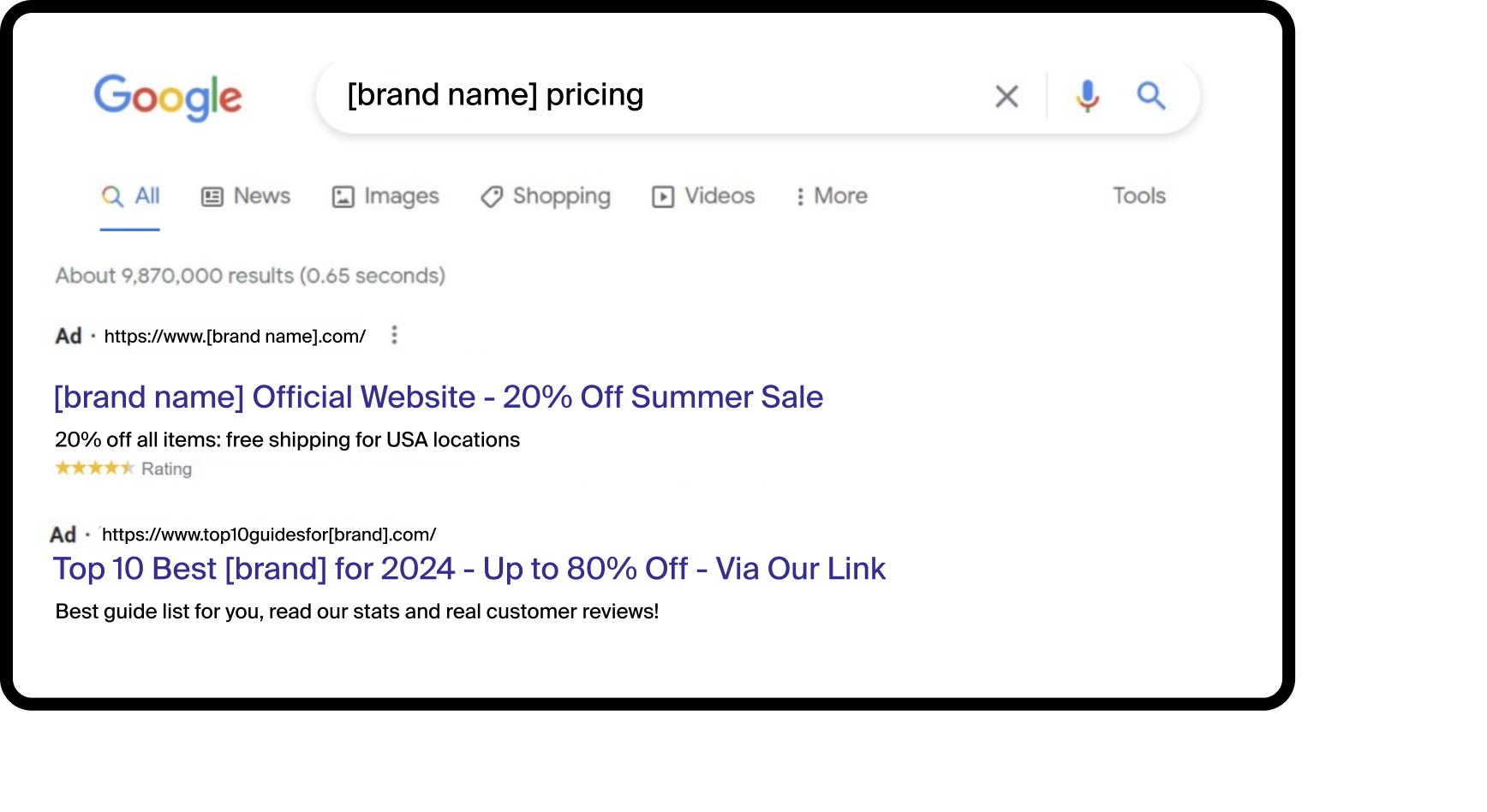Ad hijacking, also known as brand bidding fraud or PPC (pay-per-click) hijacking, is a pervasive issue in digital marketing that can severely damage your brand’s reputation and profitability. As a marketing professional specializing in Google search marketing and analytics, I’ve encountered many cases of ad hijacking and learned valuable lessons on protecting brand integrity.
In this article, we’ll explore some essential things you need to know to safeguard your brand from ad hijacking, providing detailed insights and actionable steps.
What is Ad Hijacking?
Ad hijacking occurs when unauthorized third parties use a brand’s name or keywords to run advertisements without permission. These ads often lead users to websites that are not affiliated with the brand, sometimes even malicious or counterfeit sites. The primary goal of hijackers is to divert traffic and revenue from the legitimate brand, capitalizing on the brand’s reputation to deceive customers.

Example: Suppose you’re running a Google Ads campaign for your company’s new product line. You notice a sudden drop in traffic and conversions. Upon investigation, you discover several ads mimicking your brand, leading customers to a competitor’s site or a fraudulent page. This is a classic case of ad hijacking.
4 Essential Steps to Protect Your Brand
1. Monitor Your Brand Keywords and Ads
Monitoring your brand keywords and ads is a crucial step in preventing ad hijacking. This process involves regularly checking search engine results pages (SERPs) for any unauthorized use of your brand’s keywords. Here’s a deeper dive into the methods and tools you can use:
Automated Alerts and Tools
Set up automated alerts for your brand’s name and related keywords using tools like Google Alerts. This tool sends notifications whenever your keywords appear online, helping you quickly identify unauthorized ads or content. Additionally, advanced SEO tools like SEMrush and Ahrefs can provide detailed insights into keyword rankings and competitors’ activities, allowing you to spot any unusual or unauthorized behavior.
Manual Checks
While automation is essential, manual checks are also crucial. Regularly search for your brand’s keywords on different search engines and review the ads displayed. Pay attention to the ad copy, URLs, and landing pages. Look for inconsistencies or signs of mimicry, such as slightly altered brand names or misleading domain names. Lastly, I usually perform the easiest form of checking, which is to search your brand on any search engine to see which other brands are appearing below or above my results and see instantly which brands are actively targeting your brand in their ads.
Competitive Analysis
Understanding your competitive landscape can also help identify potential hijacking. Analyze your competitors’ ad strategies and monitor if they are bidding on your brand keywords. While some competition is expected, excessive bidding on your brand keywords, especially from unrelated industries, can indicate possible hijacking attempts.
Example: A popular skincare brand noticed a sudden drop in their PPC campaign performance. Upon investigation, they found that several ads using their brand name were leading to a competitor’s website. The competitor had set up ads with similar keywords but misleading URLs, usually their own URLs, to “steal” your traffic, causing confusion among customers. By setting up alerts and conducting manual checks, the brand was able to identify and report the issue, regaining control over their ad traffic.
2. Implement Strong Trademark Protections
Trademarking your brand’s name and associated keywords is a powerful legal measure to prevent ad hijacking. Here’s a more detailed explanation of the process and benefits:
Trademark Registration
Start by registering your brand’s name, logo, and any distinctive features with the appropriate trademark authorities in your region. In the United States, this would be the United States Patent and Trademark Office (USPTO). Ensure that you also register variations of your brand name that are commonly used by customers, as hijackers often target these to deceive users. That way for example Google will prevent your competitors using your brand name in their ads, by limiting or even disapproving their ads.
Enforcement and Reporting
Once your trademark is registered, you can enforce your rights by monitoring the use of your trademarked terms. If you discover unauthorized use, you can file a complaint with the search engines or platforms where the ads appear. For instance, Google allows trademark owners to submit complaints through their Trademark Policy page. By providing proof of ownership and details of the infringement, you can request the removal of infringing ads.
Legal Action
In cases of persistent or severe ad hijacking, legal action may be necessary. Consult with a legal professional to understand your options for suing the infringers. Legal action not only helps in removing the infringing ads but also acts as a deterrent to future hijackers.
Learning
A renowned electronics company faced significant revenue loss due to a hijacker who set up ads using their trademarked keywords. The hijacker’s ads led to a counterfeit product site, damaging the brand’s reputation. The company, armed with a registered trademark, quickly filed complaints with Google and initiated legal proceedings. Within a week, the fraudulent ads were removed, and the counterfeit site was shut down. This experience underscored the importance of trademark protection as a robust defense against ad hijacking.

Additional Tips
- Expand Trademark Coverage: Consider trademarking your brand’s slogan, product names, and even specific campaigns if they have significant brand value.
- Global Protection: If your brand operates internationally, ensure that you register your trademarks in all relevant countries. Different regions have varying laws and processes, so work with local legal experts to navigate these complexities.
By combining vigilant monitoring with strong trademark protections, you can create a robust defense against ad hijacking. These measures not only protect your brand’s reputation and revenue but also enhance customer trust by ensuring that they interact with authentic and safe digital assets.
3. Leverage Ad Verification Services
Ad verification services play a critical role in maintaining the integrity of your advertising campaigns. These services offer comprehensive monitoring and analysis of your ads’ placements, ensuring they are displayed in appropriate contexts and protecting against various forms of ad fraud, including ad hijacking.
How Ad Verification Services Work
Ad verification platforms, such as DoubleVerify, Moat, and Integral Ad Science, use advanced technology to monitor the delivery of digital ads across multiple platforms and devices. They check whether ads appear in the right geographical locations, on brand-safe websites, and in front of the intended audience. They also verify that ads are not being served alongside inappropriate or harmful content.
Detection of Ad Hijacking
One of the key features of ad verification services is their ability to detect ad hijacking. These services can identify when your ads are being intercepted or redirected by unauthorized parties. They provide detailed reports, highlighting any suspicious activities such as unusual click patterns, unauthorized ad placements, or traffic from dubious sources.
Real-Time Monitoring and Reporting
Ad verification services offer real-time monitoring and reporting, allowing you to respond quickly to any issues. For example, if a competitor or malicious actor hijacks your ad traffic, you can receive immediate alerts and take corrective actions, such as pausing the affected campaign or blocking specific IP addresses.
Example: A leading e-commerce retailer noticed a drop in the ROI of their online ad campaigns. By using an ad verification service, they discovered that 20% of their ad impressions were being hijacked, leading to fake product listings. The verification service provided detailed logs of the fraudulent activity, enabling the retailer to take swift action. They reported the issue to the ad network, which resulted in the removal of the fraudulent ads and the recovery of a substantial portion of their ad spend.
Best Practices for Using Ad Verification Services
- Choose the Right Service: Select an ad verification service that aligns with your specific needs, such as brand safety, viewability, or fraud detection.
- Integrate with Existing Tools: Ensure that the ad verification service integrates seamlessly with your existing ad tech stack, including DSPs (demand-side platforms) and analytics tools.
- Regular Audits: Conduct regular audits of your ad campaigns using the verification service. This helps maintain transparency and accountability, ensuring that your ads are always served in the right contexts.
4. Educate Your Team and Partners
Educating your marketing team and partners is essential to preventing ad hijacking. A well-informed team can recognize the signs of ad fraud and take proactive measures to protect the brand.
Training and Workshops
Organize regular training sessions and workshops focused on digital ad security. These sessions should cover various topics, including the nature of ad hijacking, the importance of brand protection, and the latest trends in digital ad fraud. Training should also include practical exercises, such as identifying fraudulent ads and reporting them to the appropriate authorities.
Awareness Campaigns
Create awareness campaigns within your organization to highlight the risks of ad hijacking. Use internal communications, such as newsletters and intranet posts, to share updates on security protocols and best practices. Encourage employees to stay vigilant and report any suspicious activities.
Collaboration with Partners
Your external partners, such as ad agencies, affiliates, and vendors, play a crucial role in maintaining brand safety. Ensure they are aware of your brand protection policies and procedures. Share your expectations regarding the use of brand keywords and the monitoring of ad placements. Regularly communicate with them to discuss any concerns or issues related to ad hijacking.
Example: A software company noticed unusual activity in their PPC campaigns, with a spike in clicks but no corresponding increase in conversions. They held an emergency training session with their marketing team and partners to address the issue. During the session, they identified several unauthorized ads that were mimicking their brand. The team quickly reported these ads to the ad network and launched an internal campaign to raise awareness about the signs of ad hijacking. This proactive approach helped the company mitigate the impact of the hijacking and reinforced a culture of vigilance.
Establishing a Response Plan
Develop a clear response plan for dealing with ad hijacking incidents. The plan should outline the steps to take when suspicious activity is detected, including identifying the source, reporting the issue, and communicating with stakeholders. Assign specific roles and responsibilities to team members to ensure a swift and coordinated response.
Best Practices for Team and Partner Education
- Update Training Materials Regularly: As digital ad fraud tactics evolve, ensure that your training materials are updated regularly to reflect the latest threats and security measures.
- Foster Open Communication: Encourage an open dialogue about ad security within your organization. Create a safe environment where employees can share their concerns and observations without fear of reprisal.
- Recognize and Reward Vigilance: Acknowledge and reward team members who demonstrate exceptional vigilance and initiative in protecting the brand. This can help foster a culture of accountability and proactive engagement.
By educating your team and partners, you not only enhance your brand’s defense against ad hijacking but also build a knowledgeable and vigilant workforce committed to maintaining brand integrity. This collective effort is crucial in an ever-changing digital landscape where threats can emerge from unexpected sources.
Addressing Ad Hijacking in Your Digital Strategy
Ad hijacking is a complex and evolving challenge. As marketers, we must stay informed about the latest tactics used by hijackers and continuously adapt our strategies. Integrating ad verification services, legal protections, and comprehensive monitoring into your digital strategy can significantly reduce the risk of ad hijacking. Additionally, maintaining open communication with your team and partners ensures everyone is aligned in protecting your brand’s reputation and integrity.
Do you need help addressing ad hijacking? Don’t go in alone.






